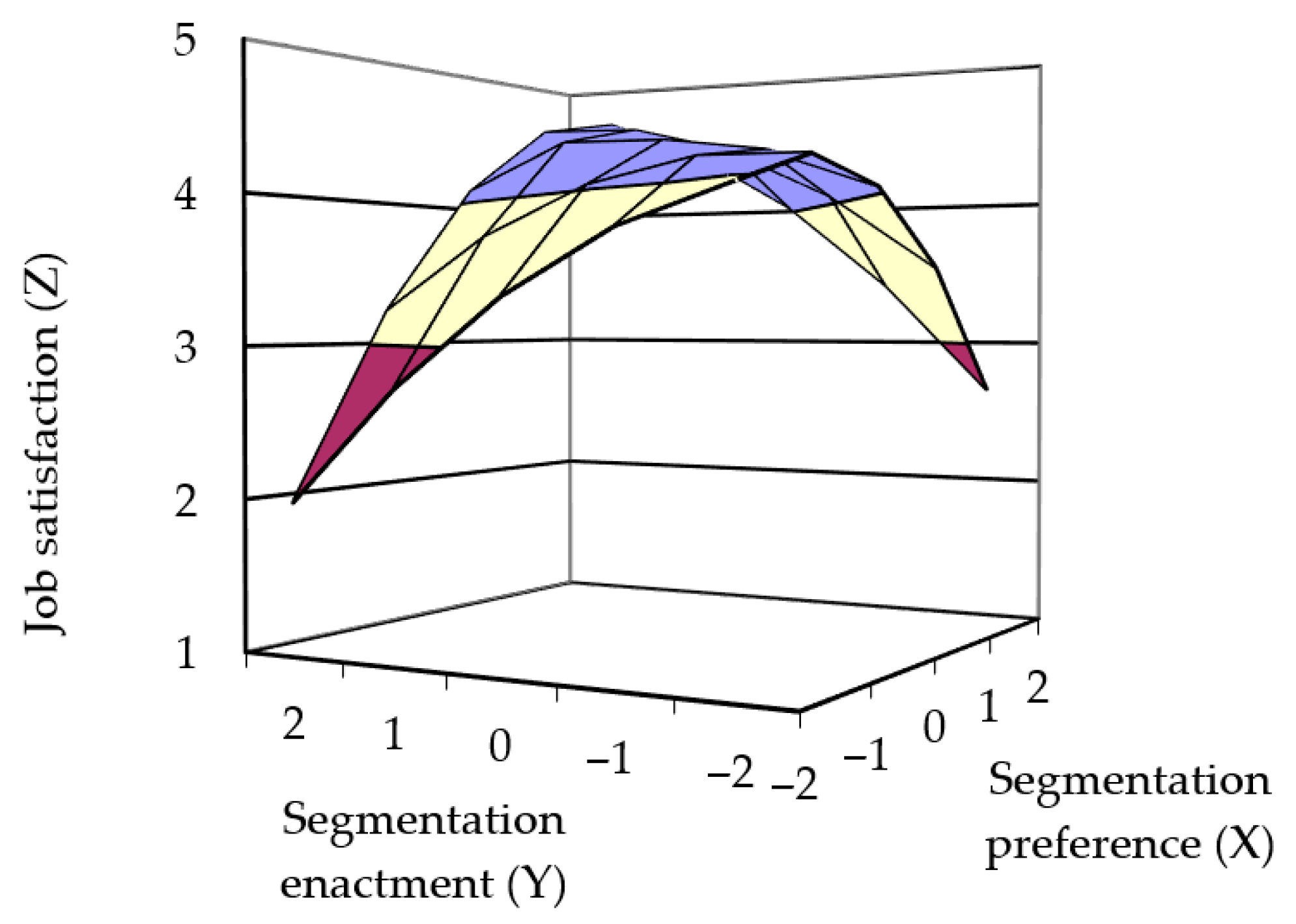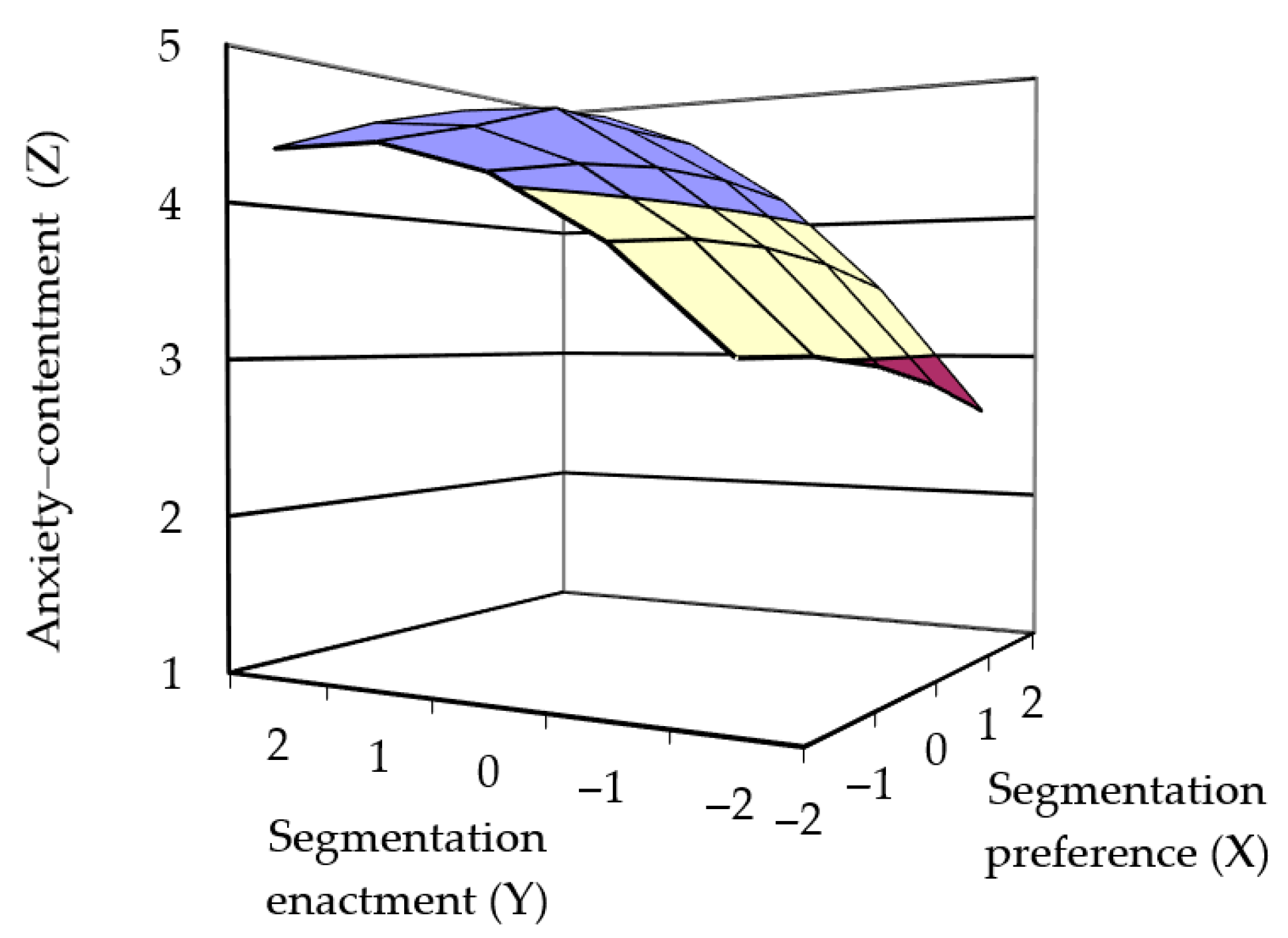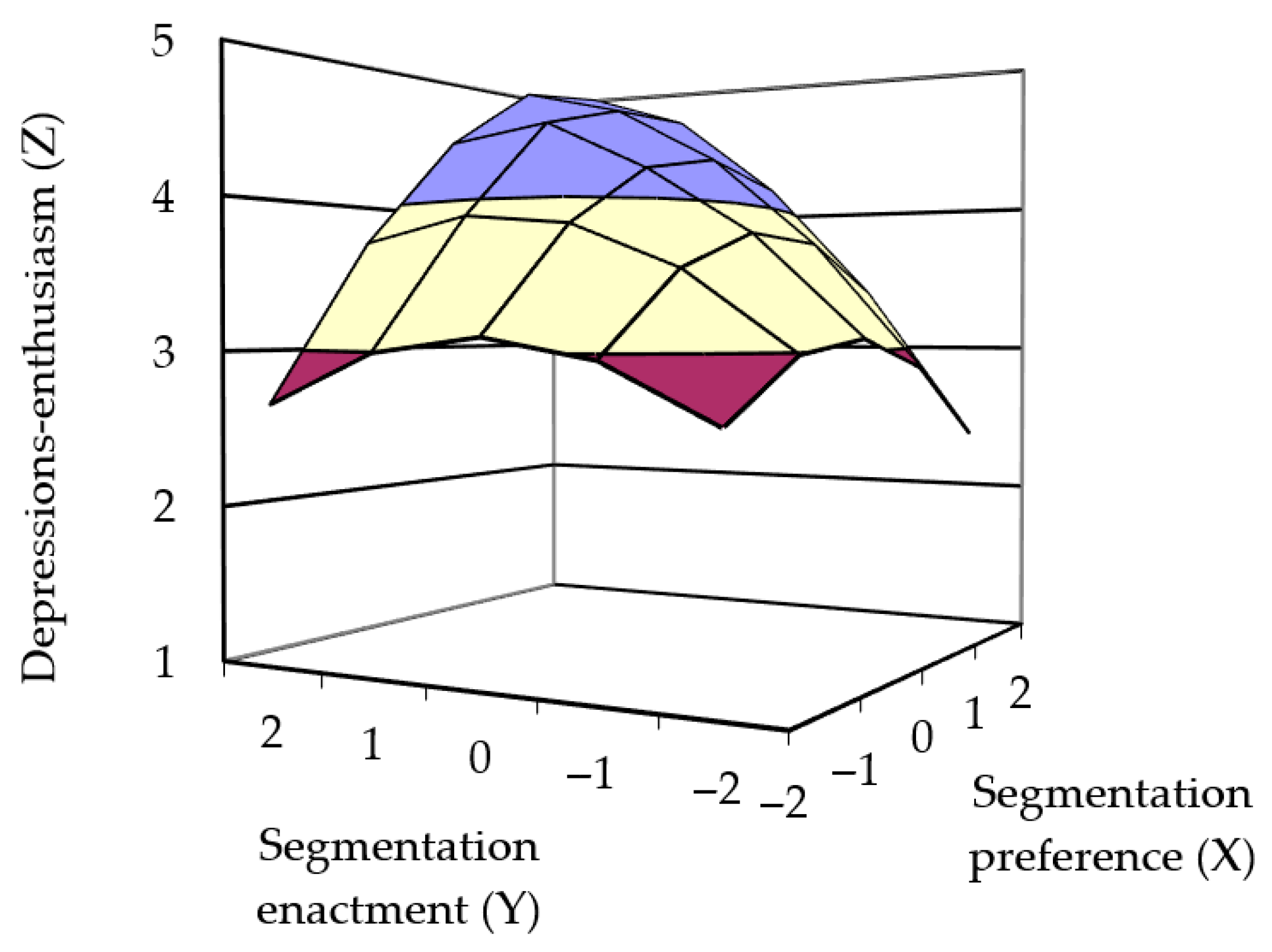Work–Family Boundary Fit and Employee Well-Being: The Mediating Role of Work–Family Conflict
Abstract
1. Introduction
2. Literature Review and Hypotheses
2.1. Boundary Theory and Boundary Management
2.2. Pairing of Boundary Preference and Actual Boundary Enactment
2.3. The Relationship Between the Consistency of Boundary Preference and Boundary Enactment and Well-Being
2.4. The Mediating Role of Work–Family Conflict
3. Methods
3.1. Procedure and Sample
3.2. Measures
3.2.1. Work–Family Boundary Preference
3.2.2. Work–Family Boundary Enactment
3.2.3. Work–Family Conflict
3.2.4. Employee Well-Being
3.2.5. Control Variables
3.3. Analyses
4. Results
Hypothesis Testing
5. Discussion
6. Conclusions
6.1. Theoretical Implications
6.2. Practical Implications
6.3. Limitations and Future Directions
Author Contributions
Funding
Institutional Review Board Statement
Informed Consent Statement
Data Availability Statement
Acknowledgments
Conflicts of Interest
Correction Statement
References
- Abdou, A. H., El-Amin, M. A.-M., Mohammed, E. F. A., Alboray, H. M. M., Refai, A. M. S., Almakhayitah, M. Y., Albohnayh, A. S. M., Alismail, A. M., Almulla, M. O., & Alsaqer, J. S. (2024). Work stress, work-family conflict, and psychological distress among resort employees: A JD-R model and spillover theory perspectives. Frontiers in Psychology, 15, 1326181. [Google Scholar] [CrossRef]
- Allen, T. D., Cho, E., & Meier, L. L. (2014). Work–family boundary dynamics. Annual Review of Organizational Psychology and Organizational Behavior, 1(1), 99–121. [Google Scholar] [CrossRef]
- Allen, T. D., & Finkelstein, L. M. (2014). Work-family conflict among members of full-time dual-earner couples: An examination of family life stage, gender, and age. Journal of Occupational Health Psychology, 19(3), 376–384. [Google Scholar] [CrossRef]
- Amirkamali, F., Casper, W. J., Hyde, S. A., Wayne, J. H., & Vaziri, H. (2024). Setting our boundaries: The role of gender, values, and role salience in work–home boundary permeability. Journal of Occupational & Organizational Psychology, 97(3), 1076–1099. [Google Scholar]
- Ammons, S. K. (2013). Work-family boundary strategies: Stability and alignment between preferred and enacted boundaries. Journal of Vocational Behavior, 82(1), 49–58. [Google Scholar] [CrossRef] [PubMed]
- Ashforth, B. E., Kreiner, G. E., & Fugate, M. E. L. (2000). All in a day’s work: Boundaries and micro role transitions. Academy of Management Review, 25(3), 472–491. [Google Scholar] [CrossRef]
- Bölingen, F., Carrillo, A., & Weller, I. (2023). Opening the doors for spillovers: A contingency view of the effects of work from home on the work-home interface. Frontiers in Psychology, 14, 1191657. [Google Scholar] [CrossRef]
- Bulger, C. A., Matthews, R. A., & Hoffman, M. E. (2007). Work and personal life boundary management: Boundary strength, work/personal life balance, and the segmentation-integration continuum. Journal of Occupational Health Psychology, 12(4), 365. [Google Scholar] [CrossRef]
- Carvalho, V., Estreder, Y., Chambel, M., & Castanheira, F. (2025). Telework during and after COVID-19: The role of FSSB and boundary management in teleworkers’ well-being. Stress and Health, 41(1), e70019. [Google Scholar] [CrossRef] [PubMed]
- Chuang, Y.-T., Chiang, H.-L., & Lin, A.-P. (2025). Insights from the job demands–resources model: AI’s dual impact on employees’ work and life well-being. International Journal of Information Management, 83, 102887. [Google Scholar] [CrossRef]
- Clark, S. C. (2000). Work/family border theory: A new theory of work/family balance. Human relations, 53(6), 747–770. [Google Scholar] [CrossRef]
- Deci, E. L., Connell, J. P., & Ryan, R. M. (1989). Self-determination in a work organization. Journal of Applied Psychology, 74(4), 580–590. [Google Scholar] [CrossRef]
- Desrochers, S., Hilton, J. M., & Larwood, L. (2005). Preliminary validation of the work-family integration-blurring scale. Journal of Family Issues, 26(4), 442–466. [Google Scholar] [CrossRef]
- Desrochers, S., & Morgan, C. (2021). Boundary theory and work-family border theory research: A focus on boundary enactment. Work and Family Researchers Network, Work and Family Encyclopedia, 18, 2023. [Google Scholar]
- Diener, E. (1984). Subjective well-being. Psychological Bulletin, 95(3), 542–575. [Google Scholar] [CrossRef]
- Edwards, J. R., & Cable, D. M. (2009). The value of value congruence. Journal of Applied Psychology, 94(3), 654–677. [Google Scholar] [CrossRef]
- Edwards, J. R., & Parry, M. E. (1993). On the use of polynomial regression equations as an alternative to difference scores in organizational research. Academy of Management, 36(6), 1577–1613. [Google Scholar] [CrossRef]
- Edwards, J. R., & Rothbard, N. P. (2000). Mechanisms linking work and family: Clarifying the relationship between work and family constructs. Academy of Management Review, 25(1), 178–199. [Google Scholar] [CrossRef]
- Foucreault, A., Ollier-Malaterre, A., & Ménard, J. (2018). Organizational culture and work–life integration: A barrier to employees’ respite? The International Journal of Human Resource Management, 29(16), 2378–2398. [Google Scholar] [CrossRef]
- Fu, J., Zhang, L., Zhao, J., & Qian, J. (2021). Influence of employee-supervisor boundary segmentation preference fit on employees’ innovative behavior. Chinese Journal of Management, 18(4), 521–530+538. [Google Scholar]
- Goodman, L. A. (1961). Snowball sampling. Annals of Mathematical Statistics, 32(1), 148–170. [Google Scholar] [CrossRef]
- Greenhaus, J. H., & Beutell, N. J. (1985). Sources of conflict between work and family roles. Academy of Management Review, 10(1), 76–88. [Google Scholar] [CrossRef]
- Hackman, J. R., & Lawler, E. E. (1971). Employee reactions to job characteristics. Journal of Applied Psychology Monograph, 55(3), 259–286. [Google Scholar] [CrossRef]
- Hobfoll, S. E. (1989). Conservation of resources: A new attempt at conceptualizing stress. American Psychologist, 44(3), 513–524. [Google Scholar] [CrossRef]
- Judge, T. A., Ilies, R., & Scott, B. A. (2006). Work–family conflict and emotions: Effects at work and at home. Personnel Psychology, 59(4), 779–814. [Google Scholar] [CrossRef]
- Kahn, R. L., Wolfe, D. M., Quinn, R. P., Snoek, J. D., & Rosenthal, R. A. (1964). Organizational stress: Studies in role conflict and ambiguity. Wiley. [Google Scholar]
- Kossek, E. E., Pichler, S., Bodner, T., & Hammer, L. B. (2011). Workplace social support and work–family conflict: A meta-analysis clarifying the influence of general and work–family-specific supervisor and organizational support. Personnel Psychology, 64(2), 289–313. [Google Scholar] [CrossRef]
- Kreiner, G. E. (2006). Consequences of work-home segmentation or integration: A person-environment fit perspective. Journal of Organizational Behavior, 27(4), 485–507. [Google Scholar] [CrossRef]
- Kristof-Brown, A. L., Zimmerman, R. D., & Johnson, E. C. (2005). Consequences of individuals‘fit at work: A meta-analysis of person–job, person–organization, person–group, and person–supervisor fit. Personnel Psychology, 58(2), 281–342. [Google Scholar] [CrossRef]
- Lin, Q., Guan, W., & Zhang, N. (2022). Work-family conflict, family well-being and organizational citizenship behavior: A moderated mediation model. International Journal of Conflict Management, 33(1), 47–65. [Google Scholar] [CrossRef]
- Ma, H., Shen, C., Yang, J., Tang, H., & Xie, J. (2014). Boundary flexibility and work-family conflict and enrichment: From person-environment fit perspective. Acta Psychologica Sinica, 46(4), 540–551. [Google Scholar] [CrossRef]
- Ma, L., & Ma, M.-y. (2019). Employee-organization boundary management fit and job satisfaction—The moderate effects of work-family facilitation. Soft Science, 33(10), 82–86, 92. [Google Scholar]
- Ma, L., & Xu, C. (2011). Boundary management and work-family interface: From person-environment fit perspective. Nankai Business Review, 14(5), 41–47, 152. [Google Scholar]
- Matthews, R. A., & Barnes Farrell, J. L. (2010). Development and initial evaluation of an enhanced measure of boundary flexibility for the work and family domains. Journal of Occupational Health Psychology, 15(3), 330–346. [Google Scholar] [CrossRef] [PubMed]
- Mellner, C., Peters, P., Dragt, M. J., & Toivanen, S. (2021). Predicting work-life conflict: Types and levels of enacted and preferred work-nonwork boundary (in) congruence and perceived boundary control. Frontiers in Psychology, 12, 772537. [Google Scholar] [CrossRef] [PubMed]
- Michel, J. S., Rotch, M. A., & O’Neill, S. K. (2022). The effects of work and nonwork boundary fit on role satisfaction and subjective well-being. Stress and Health, 38(1), 163–170. [Google Scholar] [CrossRef] [PubMed]
- Mielniczuk, E., & Łaguna, M. (2018). The factorial structure of job-related affective well-being: Polish adaptation of the Warr’s measure. International Journal of Occupational Medicine and Environmental Health, 31(4), 429–443. [Google Scholar] [CrossRef]
- Netemeyer, R. G., Boles, J. S., & McMurrian, R. (1996). Development and validation of work–family conflict and family–work conflict scales. Journal of Applied Psychology, 81(4), 400. [Google Scholar] [CrossRef]
- Nippert-Eng, C. (1996). Home and work. University of Chicago Press. [Google Scholar]
- Patrick, H., Knee, C. R., Canevello, A., & Lonsbary, C. (2007). The role of need fulfillment in relationship functioning and well-being: A self-determination theory perspective. Journal of Personality and Social Psychology, 92(3), 434–457. [Google Scholar] [CrossRef]
- Powell, G. N., & Greenhaus, J. H. (2010). Sex, gender, and the work-to-family interface: Exploring negative and positive interdependencies. Academy of Management Journal, 53(3), 513–534. [Google Scholar] [CrossRef]
- Reinke, K., & Gerlach, G. I. (2022). Linking availability expectations, bidirectional boundary management behavior and preferences, and employee well-being: An integrative study approach. Journal of Business and Psychology, 37(4), 695–715. [Google Scholar] [CrossRef]
- Rothbard, N. P., Phillips, K. W., & Dumas, T. L. (2005). Managing Multiple Roles: Work-Family Policies and Individuals’ Desires for Segmentation. Organization Science, 16(3), 243–258. [Google Scholar] [CrossRef]
- Ryan, R. M., & Deci, E. L. (2000). Self-determination theory and the facilitation of intrinsic motivation, social development, and well-being. American Psychologist, 55(1), 68–78. [Google Scholar] [CrossRef] [PubMed]
- Shanock, L. R., Baran, B. E., Gentry, W. A., Pattison, S. C., & Heggestad, E. D. (2010). Polynomial regression with response surface analysis: A powerful approach for examining moderation and overcoming limitations of difference scores. Journal of Business and Psychology, 25(4), 543–554. [Google Scholar] [CrossRef]
- Urbanaviciute, I., Lazauskaite-Zabielske, J., & Ziedelis, A. (2023). Re-drawing the line: Work-home boundary management profiles and their dynamics during the pandemic. Applied Psychology, 72(4), 1506–1527. [Google Scholar] [CrossRef]
- Warr, P. (1990). The measurement of well-being and other aspects of mental health. Journal of Occupational Psychology, 63(3), 193–210. [Google Scholar] [CrossRef]
- Weinert, C., Maier, C., Laumer, S., & Weitzel, T. (2024). How embeddedness influences IT-induced work–home boundary reduction, work–home conflict, and job outcomes. Information & Management, 61(3), 103929. [Google Scholar]
- Wepfer, A. G., Allen, T. D., Brauchli, R., Jenny, G. J., & Bauer, G. F. (2017). Work-life boundaries and well-being: Does work-to-life integration impair well-being through lack of recovery? Journal of Business and Psychology, 33(6), 727–740. [Google Scholar] [CrossRef]
- Wood, S., Daniels, K., & Ogbonnaya, C. (2018). Use of work–nonwork supports and employee well-being: The mediating roles of job demands, job control, supportive management and work–nonwork conflict. The International Journal of Human Resource Management, 31(14), 1793–1824. [Google Scholar] [CrossRef]
- Zhang, B., Jia, S., Lu, L., & Chang, M. (2024). Unethical pro-organizational behavior and unethical pro-family behavior: The roles of work-to-family conflict and work-home segmentation preference. Journal of Psychology, 90(12), 1–24. [Google Scholar] [CrossRef] [PubMed]




| Mean | SD | 1 | 2 | 3 | 4 | 5 | |
|---|---|---|---|---|---|---|---|
| 1. Boundary preference | 4.13 | 0.54 | |||||
| 2. Boundary enactment | 3.50 | 0.66 | 0.24 *** | ||||
| 3. Job satisfaction | 3.73 | 0.81 | 0.02 | 0.22 *** | |||
| 4. Anxiety–contentment | 3.70 | 0.77 | 0.09 | 0.45 *** | 0.40 *** | ||
| 5. Depression–enthusiasm | 4.01 | 0.81 | 0.13 ** | 0.42 *** | 0.45 *** | 0.71 *** | |
| 6. Work–family conflict | 2.59 | 0.86 | −0.13 ** | −0.50 *** | −0.36 *** | −0.53 *** | −0.49 *** |
| Job Satisfaction | Anxiety–Contentment | Depression–Enthusiasm | |
|---|---|---|---|
| Preference for segmentation | 0.18 | 0.02 | 0.28 |
| Segmentation enactment | 0.01 | 0.45 ** | 0.35 * |
| Preference for segmentation Sqd. | −0.18 * | −0.04 | −0.15 |
| Preference × Enactment | 0.25 * | 0.07 | 0.17 |
| Segmentation enactment Sqd. | −0.08 | −0.11 | −0.12 |
| R2 | 0.12 | 0.23 | 0.21 |
| ΔR2 | 0.05 *** | 0.13 *** | 0.14 *** |
| Linear shape along P = E (b1 + b2) | 0.19 | 0.48 ** | 0.63 ** |
| Curvilinear shape along P = E (b3 + b4 + b5) | −0.01 | −0.08 | −0.10 |
| Linear shape along P = −E (b1 − b2) | 0.17 | −0.43 * | −0.07 |
| Curvilinear shape along P = E (b3 − b4 + b5) | −0.52 ** | −0.21 | −0.43 ** |
| Variables | Job Satisfaction | Anxiety–Contentment | Depression–Enthusiasm |
|---|---|---|---|
| Mediating Effect | −0.33 (−0.47,−0.21) | −0.40 (−0.54, −0.27) | −0.40 (−0.55, −0.27) |
| Direct Effect | −0.12 (−0.35, 0.12) | −0.39 *** (−0.59, −0.19) | −0.42 *** (−0.64, −0.21) |
| Work–family Conflict | −0.33 *** (−0.43, −0.23) | −0.40 *** (−0.48, −0.31) | −0.40 *** (−0.50, −0.31) |
Disclaimer/Publisher’s Note: The statements, opinions and data contained in all publications are solely those of the individual author(s) and contributor(s) and not of MDPI and/or the editor(s). MDPI and/or the editor(s) disclaim responsibility for any injury to people or property resulting from any ideas, methods, instructions or products referred to in the content. |
© 2025 by the authors. Licensee MDPI, Basel, Switzerland. This article is an open access article distributed under the terms and conditions of the Creative Commons Attribution (CC BY) license (https://creativecommons.org/licenses/by/4.0/).
Share and Cite
Meng, Y.; Li, H.; Qu, Y.; Yu, G. Work–Family Boundary Fit and Employee Well-Being: The Mediating Role of Work–Family Conflict. Behav. Sci. 2025, 15, 1122. https://doi.org/10.3390/bs15081122
Meng Y, Li H, Qu Y, Yu G. Work–Family Boundary Fit and Employee Well-Being: The Mediating Role of Work–Family Conflict. Behavioral Sciences. 2025; 15(8):1122. https://doi.org/10.3390/bs15081122
Chicago/Turabian StyleMeng, Ying, Hongying Li, Yong Qu, and Guilan Yu. 2025. "Work–Family Boundary Fit and Employee Well-Being: The Mediating Role of Work–Family Conflict" Behavioral Sciences 15, no. 8: 1122. https://doi.org/10.3390/bs15081122
APA StyleMeng, Y., Li, H., Qu, Y., & Yu, G. (2025). Work–Family Boundary Fit and Employee Well-Being: The Mediating Role of Work–Family Conflict. Behavioral Sciences, 15(8), 1122. https://doi.org/10.3390/bs15081122






